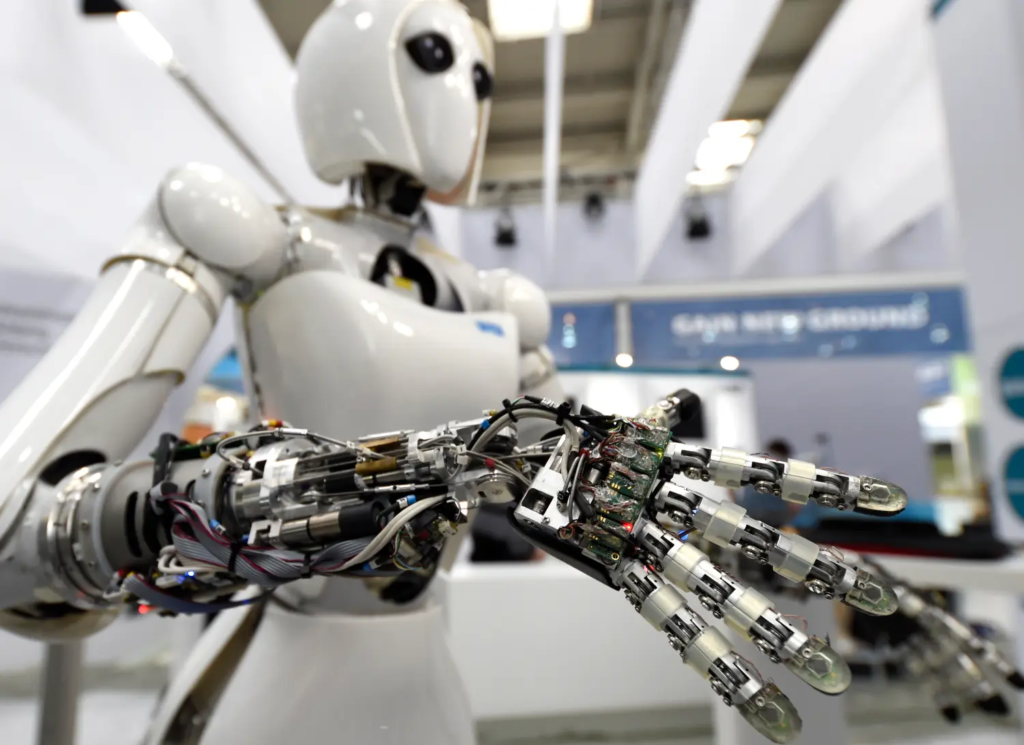
The Science of Robotics: How Robots Are Made and How They Work
Introduction
The field of robotics has advanced rapidly, becoming an integral part of modern society. Robots have moved beyond industrial use into healthcare, military, space exploration, and even personal life. From autonomous drones and robotic vacuum cleaners to life-saving surgical robots, their versatility and efficiency are revolutionizing multiple sectors. As technology evolves, robots become more intelligent, autonomous, and capable of performing complex tasks that benefit humanity. This article delves into the science of how robots are made and how they work, covering their components, engineering processes, applications, and the critical role artificial intelligence (AI) plays in shaping robotic systems.
I. What is a Robot?
Definition and Classification
A robot is a programmable machine designed to carry out tasks autonomously or semi-autonomously, often performing tasks that are either repetitive, dangerous, or beyond human capability. There are several classifications of robots based on their function and design:
- Industrial Robots: These are used primarily in manufacturing settings like automotive assembly lines. They are designed for repetitive, precise tasks such as welding, painting, or assembling components.
- Service Robots: Service robots assist with everyday tasks in healthcare, homes, and service industries. These include robots that provide elder care, help with cleaning, or serve customers in restaurants.
- Autonomous Robots: Robots that operate independently of human input, like self-driving cars and drones, fall into this category. They are equipped with sophisticated sensors and AI to make real-time decisions.
- Humanoid Robots: Designed to resemble humans, these robots often have a bipedal structure and can perform tasks mimicking human movements, such as ASIMO or Sophia.
Basic Characteristics of Robots
Regardless of the specific classification, all robots share three core characteristics:
- Sensing: Robots gather data about their environment through sensors, enabling them to navigate or interact with objects.
- Control Systems: Robots use computers and algorithms to process sensor data and control their actions, making decisions or adjustments based on input.
- Actuation: Robots possess moving parts, such as wheels, arms, or legs, driven by actuators that allow them to perform physical tasks.
II. The Components of a Robot
Robots are composed of several key components, each contributing to their overall functionality.
1. Sensors
Sensors act as the “eyes” and “ears” of a robot, collecting data from the environment. Types of sensors include:
- Cameras: Used for vision, these help robots in navigation and object recognition.
- Gyroscopes and Accelerometers: These measure the robot’s orientation and movement, crucial for balancing and motion tracking.
- Pressure and Temperature Sensors: These help in detecting force or temperature changes in the robot’s surroundings, essential in tasks like handling delicate objects or ensuring safety in hazardous environments.
2. Actuators
Actuators serve as the “muscles” of a robot, converting electrical or mechanical energy into movement. They drive components such as wheels, robotic arms, or even legs. Common types of actuators include:
- Electric Motors: Frequently used in robots for their reliability and efficiency, these motors power robotic joints and wheels.
- Hydraulic Systems: These provide powerful force for larger robots, especially in industrial applications where significant strength is required.
- Pneumatic Systems: Pneumatic actuators use compressed air and are often employed in robots for tasks that require fast, repetitive motion.
3. Control System (Brain)
The control system is essentially the robot’s “brain,” consisting of a central processor or microcontroller. It executes software programs that control the robot’s actions, making real-time decisions based on the data received from sensors. AI and machine learning can further enhance the robot’s ability to make complex decisions and adapt to changing environments.
4. Power Supply
A robot’s power supply is critical to its functionality. Different robots use various power sources:
- Batteries: Common in mobile and portable robots, lithium-ion batteries are often used for their high energy density.
- Solar Power: Some autonomous robots, especially those used in space exploration, rely on solar energy to operate for extended periods.
5. End Effectors
End effectors are the tools or attachments that a robot uses to interact with the world. These can be simple grippers, welding torches, or even surgical instruments. End effectors are often customizable to perform specific tasks in industries like healthcare or manufacturing, allowing robots to handle fragile objects or manipulate heavy machinery.
III. How Robots Are Made: The Engineering Process
Creating a functional robot involves multiple stages of engineering, from design to assembly and programming.
1. Designing the Robot
The process begins with designing the robot’s structure and systems. Robotics engineers use Computer-Aided Design (CAD) software to create detailed blueprints of the robot, considering its purpose, mobility, and operational environment. For instance, a robot designed for underwater exploration will differ greatly from a robot built for factory automation in terms of materials, mobility, and power systems.
2. Building the Frame (Chassis)
The robot’s frame is its skeletal structure, which supports its components and enables movement. Lightweight materials like aluminum or carbon fiber are often used to ensure durability without compromising on mobility.
3. Assembling Mechanical Components
The next step involves assembling the motors, actuators, and other mechanical components. This process can be complex, particularly when creating precision tools like robotic arms for surgery or robotic grippers that handle delicate objects. Ensuring proper alignment and calibration of moving parts is crucial for the robot’s overall functionality.
4. Wiring and Electronics
Wiring the robot involves connecting sensors, cameras, and control systems. Engineers ensure proper communication between the control system and the mechanical components by testing connectivity and diagnosing any potential errors during assembly.
5. Programming
Once the hardware is assembled, software engineers write the code that dictates the robot’s actions. Robots are programmed using languages such as Python, C++, or specialized platforms like Robot Operating System (ROS). These programs translate user commands into specific movements and tasks. Programming is also where AI algorithms are incorporated, allowing robots to process sensor data, make decisions, and even learn over time.
IV. How Robots Work: Key Functions and Processes
Once built, robots operate through a series of functions that allow them to perceive their environment, move, and interact with the world.
1. Perception
Robots use their sensors to perceive the world around them, converting raw data into actionable information. For example, autonomous vehicles use LIDAR, radar, and cameras to detect obstacles and plot routes. Similarly, robotic vacuums scan rooms to create a map for efficient cleaning.
2. Movement and Mobility
Robots employ different movement mechanisms, including wheels, legs, or even propellers (in the case of drones). Each movement system is suited to specific environments. Drones fly using propellers and gyroscopes for stabilization, while legged robots like Boston Dynamics’ Spot can traverse uneven terrain.
3. Interaction with the Environment
Robots use their end effectors to interact with objects or their surroundings. For example, manufacturing robots equipped with welding torches perform precise welds on assembly lines, while surgical robots like da Vinci perform delicate operations in healthcare settings. AI enhances these interactions by improving precision and adaptability.
4. Autonomy and Decision-Making
Autonomous robots leverage AI to make decisions without human intervention. This includes everything from drones adjusting their flight path to avoid obstacles to industrial robots that can detect and compensate for production line errors.
V. The Role of Artificial Intelligence in Robotics
1. Machine Learning and Robotics
AI, particularly machine learning, plays a pivotal role in making robots smarter and more capable. Machine learning algorithms allow robots to learn from experience, improving their performance over time. For instance, robots used in warehouses can learn to optimize their routes for picking and packing goods, reducing time and errors.
2. AI-Powered Vision and Sensing
AI enhances the way robots perceive their environment. Through computer vision algorithms, robots can identify objects, track movement, and make intelligent decisions. For example, medical robots can analyze imaging data to identify abnormalities such as tumors, while AI-powered drones can create detailed maps of landscapes for military or agricultural purposes.
VI. Applications of Robots in the Real World
1. Manufacturing
Industrial robots are transforming manufacturing, handling repetitive tasks with unmatched precision and speed. Robots such as KUKA and Fanuc automate processes like assembling cars or electronics, increasing production efficiency while reducing human error.
2. Healthcare
Medical robots are revolutionizing healthcare. Robots like da Vinci assist surgeons with minimally invasive procedures, while rehabilitation robots help patients regain mobility after injuries. Additionally, robots are used in hospitals for tasks like delivering medication and assisting in patient care.
3. Military and Space Exploration
In military applications, robots are used for reconnaissance, bomb disposal, and even combat scenarios. PackBot, for example, assists soldiers in safely disarming explosives. In space, NASA’s Perseverance Rover is exploring Mars, performing tasks that would be impossible for humans in such extreme conditions.
4. Consumer Robotics
Robots are increasingly becoming a part of everyday life. Household robots like the Roomba vacuum cleaner help with chores, while robotic pets and personal assistants provide companionship and convenience.
VII. Challenges and Future Trends in Robotics
1. Technical Challenges
Despite the progress, robotics still faces significant technical hurdles. Battery life, for example, limits how long robots can operate autonomously. Developing robots that can adapt to complex, unpredictable environments is another challenge, requiring more advanced AI and sensory technologies.
2. Ethical and Social Implications
Robots are raising important ethical questions, particularly about job displacement and privacy. As robots become more integrated into the workforce, concerns
grow over the replacement of human jobs. Moreover, AI-powered robots capable of collecting and processing data bring up questions regarding data privacy and security.
3. Future Trends
The future of robotics is exciting, with trends like swarm robotics, where multiple robots work together to accomplish tasks, gaining traction. Collaborative robots, or cobots, designed to work alongside humans, are also emerging. Advancements in soft robotics—which use flexible materials for safer interaction with humans—and brain-machine interfaces promise to push the boundaries of what robots can achieve.
Conclusion
Robotics is an ever-evolving field that combines engineering, computer science, and AI to create machines capable of performing tasks that benefit society in countless ways. From manufacturing and healthcare to space exploration, the impact of robots is transformative. As we look to the future, the potential for robotics is limitless, but the field will need to overcome significant challenges to ensure robots are not only effective but also ethical and safe.

Robotics is a multidisciplinary field that integrates engineering, computer science, and artificial intelligence (AI) to create machines, or robots, capable of performing tasks autonomously or semi-autonomously. To fully understand how robotics works, it’s essential to explore the basic components of a robot, the processes that govern its actions, and the role of software in controlling these systems. Below is a comprehensive breakdown of how robotics works:
1. Key Components of a Robot
Robots consist of several key components that enable them to perform tasks effectively. These include:
1.1. Sensors (Perception System)
Sensors are crucial for robots as they gather data about the surrounding environment. This data is processed to help robots make decisions and carry out tasks. There are several types of sensors, each used for different purposes:
- Cameras: Used for visual input, enabling robots to recognize objects, environments, or people. Robots like autonomous cars rely on cameras for navigation.
- LIDAR (Light Detection and Ranging): Measures distances by illuminating objects with laser light and analyzing the reflected light. It’s commonly used in self-driving cars to detect obstacles.
- Gyroscopes and Accelerometers: These sensors measure orientation, balance, and movement, helping robots maintain stability.
- Pressure Sensors: Enable robots to sense force or pressure, crucial in handling delicate objects like in manufacturing or medical applications.
- Temperature Sensors: Detect changes in temperature, ensuring safe operation in environments where heat could be dangerous (e.g., firefighting robots).
1.2. Actuators (Movement System)
Actuators are the “muscles” of a robot, converting energy into mechanical movement. They allow robots to move their arms, legs, wheels, or other parts. Types of actuators include:
- Electric Motors: Used to drive the motion of wheels, robotic arms, or joints. They are the most common type of actuators found in robots.
- Hydraulic Systems: Provide strong, controlled movement, often used in heavy-duty industrial robots where a significant amount of force is required.
- Pneumatic Systems: Utilize compressed air to create movement, typically used in robots that need rapid, repetitive actions, such as in packaging industries.
1.3. Control System (Processing Unit)
The control system is the robot’s brain, made up of a central processing unit (CPU) or microcontroller that processes inputs from sensors and issues commands to actuators. It executes software programs that determine how the robot interacts with its environment. Advanced robots use AI to make more complex decisions.
- Computer Processors: Manage all computations and decision-making in the robot.
- Real-Time Operating Systems (RTOS): Used in robotics for managing real-time processes such as controlling multiple sensors, processing data, and initiating movements simultaneously.
1.4. Power Supply
A robot’s power supply provides the energy needed for sensors, actuators, and the control system to operate. Power sources vary depending on the robot’s size and purpose:
- Batteries (Lithium-Ion, Nickel-Metal Hydride): Common in mobile robots for their portability and high energy density.
- Solar Power: Used in robots designed for long-term outdoor use, such as space exploration rovers or agricultural robots.
- Hydraulic or Pneumatic Energy: In some heavy-duty industrial robots, hydraulic systems are powered by external sources of pressurized fluid or air.
1.5. End Effectors
End effectors are the tools attached to the robot’s arms that interact with objects. They can vary greatly depending on the robot’s function:
- Grippers: Used to hold, lift, or manipulate objects. Common in industrial robots that work on assembly lines.
- Welding Torches: Used in manufacturing robots for tasks like welding car frames.
- Surgical Tools: In medical robots, precision instruments are used for minimally invasive surgery.
2. How Robots Function: Basic Processes
Once a robot is assembled with all of its components, its operation involves several key processes:
2.1. Perception
Robots use sensors to perceive their environment, gathering data that is then processed by the control system. Perception involves the following steps:
- Data Collection: Sensors like cameras or LIDAR capture information (e.g., distance, speed, orientation) from the environment.
- Data Processing: The control system processes the raw data to interpret it. For instance, an autonomous car might analyze LIDAR data to detect the presence of other vehicles or obstacles.
- Decision Making: Based on processed data, the robot decides what action to take. This is where AI comes into play, helping robots make more complex decisions like route planning or object identification.
2.2. Movement and Mobility
Movement is crucial for many robots, and it is controlled by actuators that receive instructions from the control system. Robots may move in a variety of ways:
- Wheeled Robots: Use wheels for mobility, ideal for flat surfaces. They are common in warehouses or delivery robots.
- Legged Robots: Use legs for navigating rough or uneven terrain. Bipedal (two-legged) robots and quadrupedal (four-legged) robots, such as Boston Dynamics’ Spot, are examples.
- Tracked Robots: Employ tracks, like tanks, to cross challenging surfaces, including sand, mud, or rocks.
- Flying Robots (Drones): Use propellers and gyroscopes to achieve stable flight.
2.3. Interaction with the Environment
Robots interact with their surroundings through their end effectors, whether it’s picking up objects, welding parts, or performing surgery. Interaction also involves:
- Grasping and Manipulation: Robots equipped with grippers or hands can grasp, hold, and manipulate objects. AI and machine learning are often used to improve the robot’s ability to handle complex tasks, such as adjusting the grip strength based on object fragility.
- Task Execution: Robots execute tasks like assembling components, cleaning, or conducting surveillance based on pre-programmed instructions or learned behaviors.
2.4. Autonomy and Decision-Making
Modern robots are increasingly autonomous, capable of making decisions without human intervention. They can perform tasks based on real-time input from sensors and adjust their actions accordingly. For example:
- Self-driving cars: Use AI algorithms to make decisions about steering, braking, and acceleration based on sensor data.
- Warehouse Robots: Use machine learning to improve picking and packing efficiency, learning from past actions to enhance their performance.
3. The Role of Software in Robotics
Software plays a central role in controlling robots, helping them process data, make decisions, and execute tasks.
3.1. Programming Languages
Robots are programmed using various languages, including:
- Python: Common for AI and machine learning applications, Python is used for creating algorithms that help robots learn and adapt.
- C++: Widely used in robotics for its speed and performance, particularly for low-level control tasks such as motor control.
- ROS (Robot Operating System): An open-source framework used for controlling robots. It allows for modular development, making it easy to integrate different hardware and software components.
3.2. Artificial Intelligence and Machine Learning
AI is integral to the functioning of modern robots, enabling them to learn from experience and improve their performance over time. Key AI techniques in robotics include:
- Machine Learning (ML): Robots use ML to improve their decision-making and task execution. For example, industrial robots can optimize their actions based on previous performance data.
- Computer Vision: AI algorithms allow robots to “see” and recognize objects or environments, improving their ability to navigate or interact with the world.
4. Robotics in Action: Practical Applications
4.1. Manufacturing
Robots in manufacturing automate tasks such as assembly, welding, painting, and packaging. Industrial robots, like those from Fanuc and KUKA, are highly precise and efficient, reducing production costs and improving quality.
4.2. Healthcare
In healthcare, robots are used for tasks ranging from surgery (e.g., da Vinci surgical robots) to patient care (robots that assist in elderly care or rehabilitation). Robotic exoskeletons also help patients regain mobility after accidents or surgeries.
4.3. Military and Defense
Robots play a significant role in military applications, including bomb disposal, reconnaissance, and surveillance. Drones are used for aerial surveillance and targeted operations, while ground robots assist soldiers in dangerous missions.
4.4. Space Exploration
NASA’s rovers, such as Perseverance, are robots designed to explore extraterrestrial environments. These robots are equipped with sensors, cameras, and tools to perform scientific experiments and navigate alien landscapes.
4.5. Consumer Robotics
In everyday life, robots are increasingly found in homes as vacuums, personal assistants, or entertainment devices (robotic pets). Roomba is a popular robotic vacuum cleaner that autonomously cleans floors using sensors and AI algorithms.
Conclusion
Robotics is a complex, evolving field that combines hardware, software, and artificial intelligence to create machines capable of performing a wide range of tasks. From basic industrial robots to advanced autonomous systems, robots rely on sensors, actuators, control systems, and software to function. AI plays a key role in enabling robots to perceive, interact, and make autonomous decisions. The future of robotics promises even greater advancements in autonomy, flexibility, and the ability to work alongside humans in collaborative environments. As robots continue to evolve, they will have a profound impact on industries, healthcare, and daily life.






